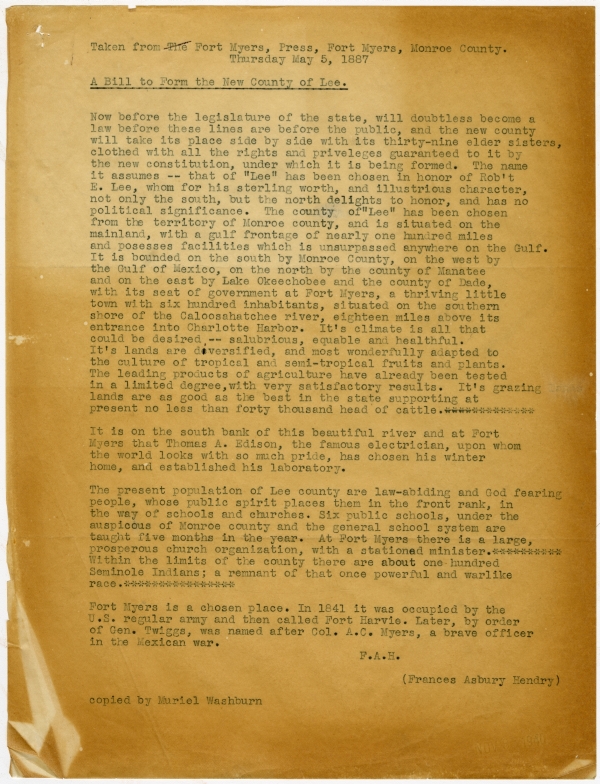Florida Memory is administered by the Florida Department of State, Division of Library and Information Services, Bureau of Archives and Records Management. The digitized records on Florida Memory come from the collections of the State Archives of Florida and the special collections of the State Library of Florida.

State Archives of Florida
- ArchivesFlorida.com
- State Archives Online Catalog
- ArchivesFlorida.com
- ArchivesFlorida.com
State Library of Florida
Related Sites

Description of previous item
Description of next item

Source
Description
Date
Contributors
Format
Coverage
Personal Subjects
Corporate Subjects
Subjects
Geographic Term
Note to Researchers:
Though the WPA field workers included extensive citations for the factual information contained in these county histories, it should be noted that these historical narratives were produced in the 1930s by federal government employees, and might reflect the inherent social biases of the era.
Now before the legislature of the state, will doubtless become a law before these lines are before the public, and the new county will take its place side by side with its thirty-nine elder sisters, clothed with all the rights and [privileges] guaranteed to it by the new constitution, under which it is being formed. The name it assumes – that of “Lee” has been chosen in honor of Rob’t E. Lee, whom for his sterling worth, and illustrious character, not only the south, but the north delights to honor, and has no political significance. The county of “Lee” has been chosen from the territory of Monroe county, and is situated on the mainland, with a gulf frontage of nearly one hundred miles and possesses facilities which is unsurpassed anywhere on the Gulf. It is bounded on the south by Monroe County, on the west by the Gulf of Mexico, on the north by the county of Manatee and on the east by Lake Okeechobee and the county of Dade, with its seat of government at Fort Myers, a thriving little town with six hundred inhabitants, situated on the southern shore of the Caloosahatchee river, eighteen miles above its entrance into Charlotte Harbor. [Its] climate is all that could be desired – salubrious, equable and healthful. [Its] lands are diversified, and most wonderfully adapted to the culture of tropical and semi-tropical fruits and plants. The leading products of agriculture have already been tested in a limited degree, with very satisfactory results. [Its] grazing lands are as good as the best in the state supporting at present no less than forty thousand head of cattle.
It is on the south bank of this beautiful river and at Fort Myers that Thomas A. Edison, the famous electrician, upon whom the world looks with so much pride, has chosen his winter home, and established his laboratory.
The present population of Lee county are law-abiding and God fearing people, whose public spirit places them in the front rank, in the way of schools and churches. Six public schools, under the [auspicious] of Monroe county and the general school system are taught five months in the year. At Fort Myers there is a large, prosperous church organization, with a stationed minister. Within the limits of the county there are about one hundred Seminole Indians; a remnant of that once powerful and warlike race.
Fort Myers is a chosen place. In 1841 it was occupied by the U.S. regular army and then called Fort Harvie. Later, by order of Gen. Twiggs, was named after Col. A.C. Myers, a brave officer in the Mexican war.
Title
Subject
Description
Creator
Source
Date
Contributor
Format
Language
Type
Identifier
Coverage
Thumbnail
Geographic Term
Display Date
ImageID
Subject - Corporate
Subject - Person
Transcript
Now before the legislature of the state, will doubtless become a law before these lines are before the public, and the new county will take its place side by side with its thirty-nine elder sisters, clothed with all the rights and [privileges] guaranteed to it by the new constitution, under which it is being formed. The name it assumes – that of “Lee” has been chosen in honor of Rob’t E. Lee, whom for his sterling worth, and illustrious character, not only the south, but the north delights to honor, and has no political significance. The county of “Lee” has been chosen from the territory of Monroe county, and is situated on the mainland, with a gulf frontage of nearly one hundred miles and possesses facilities which is unsurpassed anywhere on the Gulf. It is bounded on the south by Monroe County, on the west by the Gulf of Mexico, on the north by the county of Manatee and on the east by Lake Okeechobee and the county of Dade, with its seat of government at Fort Myers, a thriving little town with six hundred inhabitants, situated on the southern shore of the Caloosahatchee river, eighteen miles above its entrance into Charlotte Harbor. [Its] climate is all that could be desired – salubrious, equable and healthful. [Its] lands are diversified, and most wonderfully adapted to the culture of tropical and semi-tropical fruits and plants. The leading products of agriculture have already been tested in a limited degree, with very satisfactory results. [Its] grazing lands are as good as the best in the state supporting at present no less than forty thousand head of cattle.
It is on the south bank of this beautiful river and at Fort Myers that Thomas A. Edison, the famous electrician, upon whom the world looks with so much pride, has chosen his winter home, and established his laboratory.
The present population of Lee county are law-abiding and God fearing people, whose public spirit places them in the front rank, in the way of schools and churches. Six public schools, under the [auspicious] of Monroe county and the general school system are taught five months in the year. At Fort Myers there is a large, prosperous church organization, with a stationed minister. Within the limits of the county there are about one hundred Seminole Indians; a remnant of that once powerful and warlike race.
Fort Myers is a chosen place. In 1841 it was occupied by the U.S. regular army and then called Fort Harvie. Later, by order of Gen. Twiggs, was named after Col. A.C. Myers, a brave officer in the Mexican war.
Chicago Manual of Style
Works Progress Administration, Historical Records Survey. Lee County Formation. 1939 (circa). State Archives of Florida, Florida Memory. <https://www.floridamemory.com/items/show/321127>, accessed 15 December 2025.
MLA
Works Progress Administration, Historical Records Survey. Lee County Formation. 1939 (circa). State Archives of Florida, Florida Memory. Accessed 15 Dec. 2025.<https://www.floridamemory.com/items/show/321127>
AP Style Photo Citation
(State Archives of Florida/Works Progress Administration)

 Listen: The Blues Program
Listen: The Blues Program